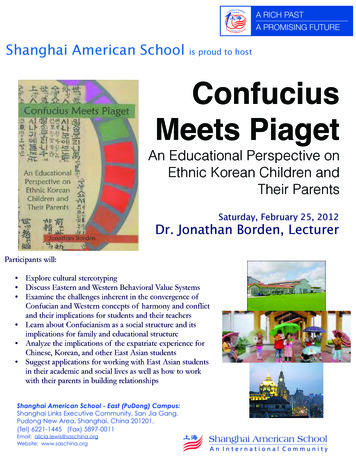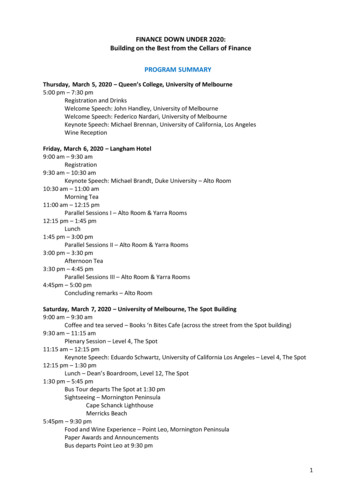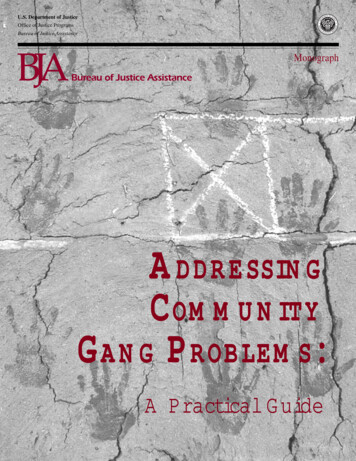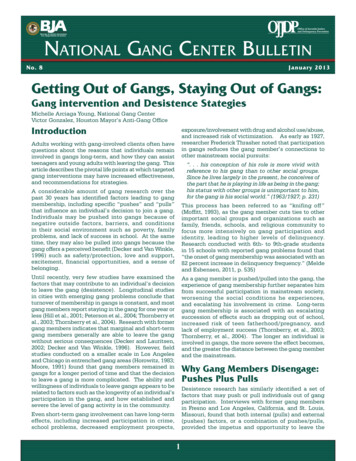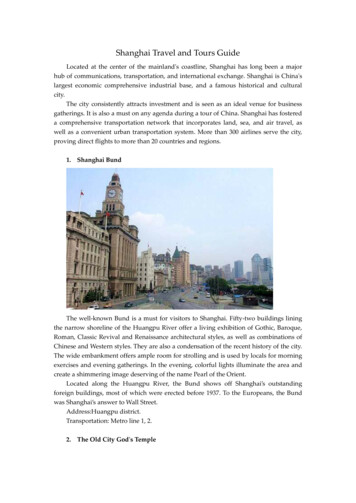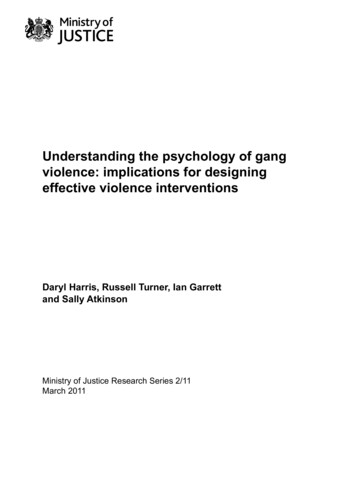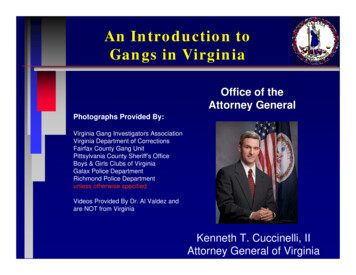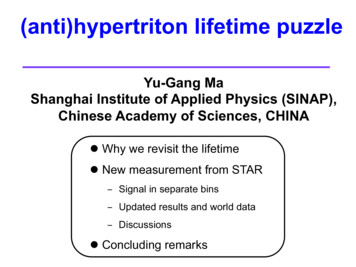
Transcription
(anti)hypertriton lifetime puzzleYu-Gang MaShanghai Institute of Applied Physics (SINAP),Chinese Academy of Sciences, CHINAl Why we revisit the lifetimel New measurement from STAR– Signal in separate bins– Updated results and world data– Discussionsl Concluding remarks
What are hypernucleus?Hypernucleus of lowest ANucleus which contains at least one hyperon in addition to nucleons.3ΛH (n p Λ )3ΛH (n p Λ ) Y-N interaction: a good window tounderstand the baryon potential Binding energy and lifetime arevery sensitive to Y-N interactions Hypertriton: ΔB 130 50 KeV; r 10fm Λ p π - (64%);Λ n π 0 (36%) Production rate via coalescenceat RHIC depends on overlapping wavefunctions of n p Λ in final state Hypertriton and anti-hypertriton ratiosThe first hypernucleus was discovered by Danysz sensitive to matter and anti-matterand Pniewski in 1952. It was formed in a cosmicprofiles in heavy-ion collisionsray interaction in a balloon-flown emulsion plate.M. Danysz and J. Pniewski, Phil. Mag. 44 (1953) 348 Important first step for searching forother exotic hypernuclei (double-Λ)The 12th International Conference on Nucleus-Nucleus Collisions (NN2015), Italy, 6/20152
From Hypernuclei to Neutron StarsNucleiBaryon-Baryon InteractionNeutron StarsS -2S -1S -0Several possible configurations of Neutron Stars– hyperons, strange quark matterSingle and double hypernuclei in the laboratory:– study the strange sector of the baryon-baryon interaction– provide info on EOS of neutron starsThe 12th International Conference on Nucleus-Nucleus Collisions (NN2015), Italy, 6/20153
TheKAMADA,mesonicdecay of hypertritonGOLAK, MIYAGAWA, WITAŁA, AND GLÖCKLEKamada et al., PRC 57, 1595(1998)TABLE I. Partial and total mesonic and nonmesonic decay rates and corresponding lifetimes.ChannelHe 1p 2 and 3 H 1 p 0d1 p 1p 2 and d1n1 p 0p 1 p 1 n 1 p 2 and p 1 n 1 n 1p 0All mesonic channelsd1 np 1n 1nAll nonmesonic channelsAll channelsExpt. @6#Expt. averaged! @11#3G @sec 21 #G/ G Lt 5G 21 @sec#0.146 310100.235 310100.368 31080.385 310100.67 31070.57 31080.64 31080.391 310100.3840.6190.00971.010.00180.0150.0171.030.684 310290.425 310290.271 310270.260 310290.15 310260.18 310270.16 310272.56 3102102.64 10.92 20.54 3102102.44 1 0.26 20.22 310210the hypertriton state has been determined in a parrepresentation and we refer to @1# for the details ofion. Here we need only the formapplication of the O matrix onto the wave funcnent of the hypertriton. This is given in AppendOnce the amplitudes N pq a u U & are determintrix element in 19! is evaluated by quadrature indescribed in @17# and references therein. The firC 3 H& 5d p p 2 dqq 2 u pq a & C a pq ! , 21!Lement in Eq. 19!, the plane wave impulse apawithCollisionsrespect tothe nucleons,also evaluated4The 12th International Conference on Nucleus-Nucleus(NN2015),Italy,is6/2015(EE
Focus on the hypertriton lifetime (1)Though the mesonic decays are Pauli blocked in heavier hypernuclei, they are thedominant channels in hypertriton.In experiment, the 2-body helium3 channel and the 3-body deuteron channel areeasier to access.The lifetime measurements are interesting especially in view of the shortvalues from early experiments :The 1st measurements is (0.95 0.19-0.15)*10-10s from helium bubble chamber, by Blocket al., presented in the proceeding of Conference on Hyperfragments at St, Cergue,1963, p.62Results from AGS nuclear-emulsion experiments: (0.9 2.2-0.4)*10-10s, Phys. Rev.136(1964) B1803,from Bevatron and AGS Phys. Rev. 139(1965) B4012-body (3 in flight, 4 at rest) (0.8 1.9-0.3)*10-10s2-body combined with 3-body (5 in flight, 18 at rest) (3.4 8.2-1.4)*10-10sNuclear-emulsion with maximum likelihood procedure, Nucl. Phys. B 16 (1970) 46,(1.28 0.35-0.26)*10-10s,The 12th International Conference on Nucleus-Nucleus Collisions (NN2015), Italy, 6/20155
Focus on the hypertriton lifetime (2)But other measurements gave different values:Helium bubble chamber from Argonne ZGS:(2.32 0.45-0.34)*10-10s, PRL 20 (1968)819(2.64 0.84-0.52)*10-10s, PRD 1(1970)66(2.46 0.62-0.41)*10-10s, NPB 67(1973)269Nuclear-emulsion from Bevatron:2-body is (2.00 1.10-0.64)*10-10s and 3-body (3.84 2.40-1.32)*10-10s,and a combined of (2.74 1.10-0.72)*10-10sPRL 20(1968)1383How about the theoretical understanding of these experimental results?The 12th International Conference on Nucleus-Nucleus Collisions (NN2015), Italy, 6/20156
Focus on the hypertriton lifetime (3)The hypertriton being a loosely-bound nuclear system, its mean lifetimeshould not be significantly different from that of the free LambdaTheoretical calculations from Dalitz et al., initially gave a short value andupdated later on a larger value close to the free Lambda’sPhys. Lett. 1 (1962) 58 and Nuovo Cimento A 46,786 (1986)The calculations based on modern 3-body interaction force, the total lifetimeis predicted to be 2.56*10-10s, Phys. Rev. C 57 (1998) 1595The hypertriton lifetime data are not sufficiently accurate to distinguishbetween models, more precise measurements are needed.The 12th International Conference on Nucleus-Nucleus Collisions (NN2015), Italy, 6/20157
Results from RHIC-STAR Col.Previous measurement (before 1973)Use nuclear emulsion or bubble chamber.A events: less2.5than 80AcceptedPrevious measurementSTAR Collaboration, Science 328 (2010)58BCountRun4 200GeV1MB22M20.5Run4 200GeV103CentralRun7 200GeVMBC 0.080456789 10 11cT (cm)68MSTAR 2012 measurement,MB 223MRun10 200GeVCentral 50free , (PDG)1003Run10 80,1307(1969)400lifetime (ps)C22cT 5.5 p 2.7 cm1.4STAR 2010 measurement1.52C 1.0845010152025Run10&11 lowMB 213Menergiesdecay-length/(B G ) (cm)50STAR free ,Dalitz, 1962PR136, 6B(1964)Glockle, 19980World dataIt is promising to obtain an improved lifetime measurement using the new dataThe 12th International Conference on Nucleus-Nucleus Collisions (NN2015), Italy, 6/20158
Relativistic heavy-ion collisionsinitial stageQGP and hydrodynamicexpansionpre-equilibriumhadronization and freeze-outCYM & LGT& clust. hadronizationu Initial condition ofPCMcollisionsu New state of matter : QGPu Hadronization and hadronic interactionNFDNFD & hadronic TMstring & hadronic TMRHIC creates hot and dense matter, containing dozens ofPCM & hadronic TMhyperons in central events : ideal source of hypernuclei studies.RHIC white paper: Nucl. Phys. A 757The 12th International Conference on Nucleus-Nucleus Collisions (NN2015), Italy, 6/20159
Relativistic Heavy Ion Collider (RHIC)PHOBOSPHENIXRHICBRAHMSSTARAGSTANDEMSThe 12th International Conference on Nucleus-Nucleus Collisions (NN2015), Italy, 6/201510
The STAR DetectorTPC: effectively 3-D ionization camera with over 50 million pixels.STAR: a complex set of various detectors, a wide range of measurements and aSTAR-TPC: NIMA 499 (2003) 659broad coverage of different physics topics.STAR-detector: NIMA 499 (2003) 624The 12th International Conference on Nucleus-Nucleus Collisions (NN2015), Italy, 6/201511
Event displaySTAR Collaboration, Science 328 (2010) 58!A beautiful event in the STAR TPC that includes the production and decay of aantihypertriton candidate. (Data taken from Run4 Au Au 200GeV MB collision)The 12th International Conference on Nucleus-Nucleus Collisions (NN2015), Italy, 6/201512
Datasets and track selectionDatasets and event statisticsRun10 7.7GeVMB 4MRun10 11.5GeV MB 11MRun11 19.6GeV MB 31MRun11 27GeVMB 49MRun10 39GeVMB 118MRun10 200GeVMB 223MRun10 200GeVCentral 199MRun7MB 56M200GeVAnalysis method: secondary vertex findingtechnique Identify 3He and π candidate Find the V0 position from daughters pairing Plot the invariant mass dis. of daughters Combinatorial background analysisThe 12th International Conference on Nucleus-Nucleus Collisions (NN2015), Italy, 6/201513
The largest Hypertriton sampleStatistics: Run7 Run10 Run11 MB Central, 610M eventsbin width 4MeVSTAR preliminarybin width 2MeVSTAR preliminarySignal observed from the data (bin-by-bin counting [2.986,2.996]GeV): 602 63,which is the largest hypertriton sample ever createdbackground: form:Background estimation: rotated backgroundThe 12th International Conference on Nucleus-Nucleus Collisions (NN2015), Italy, 6/201514
Hypertriton signal from STAR BES at sNN 7.7, 11.5, 19.6, 27, 39, 200GeVThe 12th International Conference on Nucleus-Nucleus Collisions (NN2015), Italy, 6/201515
Signal in separated decay length binsN(t) N(0) e t/τSTAR preliminary N(0) e Lβγ cτSTAR preliminarySTAR preliminaryMeasure the hypertriton signal in different L/βγ bins:2-5-8-11-41cmCombined datasetrun10: 7.7, 11.5, 39, 200GeV MiniBias,STAR preliminaryrun10: 200GeV central; run11: 19.6, 27GeV MBThe 12th International Conference on Nucleus-Nucleus Collisions (NN2015), Italy, 6/201516
Counts33Λ H Λ H102lifetime(ps)STAR PreliminarySTAR(Science 328 (2010) 58)STAR 2010 2012 combined fitSTAR 2012 Λ lifetime fit4503ΛHY.H. Zhu (SINAP), Nucl. Phys. A 904–905 (2013) 551c31033ΛH ΛHCountsNew hypertriton lifetime 0)2502200NPB16,46(1970)1τ(Λ) 260 1psχ2 0.580102.533.544.555.5decay-length/βγ (cm)RSTA51015NPB67,269(1973)PRL20,819(1968)cτ 3.69 0.77cm0.65χ2 1.58150aryni100mPreli202530decay-length/ βγ (cm)free Λ (pdg)Λ (STAR eliminarySTAR 2012 ResultDalitz, 19620Y.H. Zhu (SINAP) for STAR Col., QM2012, USAJ.H. Chen (SINAP) v, Spain26τ 123 22 10 psSTAR 2012 preliminary result:23τ 138 STAR 2010 2012 combined fit:20 psThe 12th International Conference on Nucleus-Nucleus Collisions (NN2015), Italy, 6/201517
181C. Rappold et al. / Nuclear Physics A 913 (2013) 170–184Measurement from HpyHI projectLambdaHypertritonC. Rappold et al. / Nuclear Physics A 913 (2013) 170–1844H(Lambda)181Fig. 9. (Color online.) Profiled likelihood ratio for interval estimation of Λ-hyperon (a1), Λ3 H (b1), and Λ4 H hypernuclei(c1). Interval estimation for 1 standard deviation is shown on each profiled likelihood ratio. Binned decay length distributions of the signal region of Λ-hyperon (a2), Λ3 H (b2), and Λ4 H hypernuclei (c2) with the fitted model, which includedthe exponential function resulted from the unbinned maximum likelihood fit and the background contribution estimatedby the sidebands. The black line represents the fitted model, while the blue dotted line represents the contribution of theexponential function.Table 3Contributions to the systematic errors.Contribution to the systematicΛ3ΛH4ΛHVertex Z pos (%)Primary Vertex (%)Scaling (%)Sideband (%)Total (%)84118171846620148171025Hypernuclear spectroscopy at GSI: 6Li projectiles on 12C target at 2 A GeV4.1.Fig.Studyof the systematicuncertainty9. (Coloronline.) Profiledlikelihood ratio for interval estimation of Λ-hyperon (a1), Λ3 H (b1), and Λ4 H hypernucleipresents the(c1).hypertritonlifetimemeasurement from 2-body channel:Interval estimation for 1 standard deviation is shown on each profiled likelihood ratio. Binned decay length distri42The systematic uncertainty in deducing the lifetime 3was also investigated,as summarized inbutionsof thesignal region(a2),vertexandcutΛ4wasH hypernucleiwith the fitted model, which includedTable3. First,the boundaryrangeofofΛ-hyperonthe longitudinalpositionset to several(c2)valuesΛ H (b2),32exponentialfunctionresultedthe unbinnedmaximumlikelihoodfit andthe background contribution estimatedin theorderto deduce theeffect ofthe cut fromcondition.The resultantsystematicuncertaintyis listedsidebands.The blackline representsfittedduemodel,theinblueline represents the contribution of thein bythe thesecondrow of Table3 (VertexZ pos). It isthemainlyto thewhilechangethe dotteddata sample’ssize, whichfunction.influences the fitting procedure. In the lifetime estimation, the primary vertexexponentialposition is not perfectly defined. Variations on the primary vertex can be studied to determineNucl. Phys. A 913(2013)170τ 183 37psThe 12th International Conference on Nucleus-Nucleus Collisions (NN2015), Italy, 6/201518
On the measured lifetime of light hypernuclei 3ΛH and 4ΛHC. Rappold, R. Saito et al., Phys. Lett. B 728, 543(2014) The combined analysis of the world data for the lifetime of 3ΛH and 4 ΛH gave theaverage of 3 ΛH and 4ΛH lifetime was respectively 216 19 16 ps and 192 20 18ps. With these studies, it has been revealed that the measured lifetime of 3 ΛH and 4ΛHcan be significantly shorter than that of the Λ–hyperon.The 12th International Conference on Nucleus-Nucleus Collisions (NN2015), Italy, 6/201519
The physics for short lifetime?Revisit the previous theoretical calculation:A statistical combination analysis of the experimental lifetime data give average of216 19-18 ps for hypertriton, indicated that the lifetime of light hypernuclei issignificantly shorter than the free Lambda’sRevisit binding energy (130 50 kev), STAR exp. 3-body analysis have significantprogress.(1)(2)Physics implications:(1) Loose Lambda inside hypernucleus,hypernuclear lifetime free Labmda(2) Stronger lambda-n interaction,hypernuclear lifetime free Labmda The 12th International Conference on Nucleus-Nucleus Collisions (NN2015), Italy, 6/201520
iosweretestedbyreportedinRefs.[45,46]thatnoS 1dibaryonresonancepanels (a1) and (a2) and t π in panels (b1) and (b2). Thedecay vertexpositionwas requested tobepacelongitudinaldecay isof their missing-mass(nnΛ)reaction? rk). It was shown experiment in the reaction p p K (!p). FurthermoreHypHI exp. observed asignalin the invariantmasse two-body decay the recent review from Gal [47] givespossiblestructuresofadistribution of d pi and t pisecond two-body S 1 dibaryon, excluding (!p)channel.possibility. In the reviewPRC 88,041001R(2013)nsfer, i.e., small from Dalitz and Downs [25], a !-nucleon bound state isData from HIRES Col.of three particles discarded. Those considerations mayexcludethe hypothesisExcludedthe (Lp)candidates a n! boundin the observable that the d π final state originatesPLBfrom687, 31(2010)PRD 84, 032002(2011)he second decay, state.A possible interpretation have very similarA possible interpretation for mightthe observedt πandbe the two- andthree-body decays of anin the laboratory d π final states might be the twoand three-bodyunknownbound state decaysof 2associated with amassframeofthe of an unknown bound state of twoneutronsneutronsassociated withLambda:3 mass3 distributions of d π 3 FIG. 1. (Color online)!,Invariantn,vian t πandn t π d n π,!!!final-state candidate in panels (a1) and (a2) and of t π in panels Theand International(b2).and (b1) areonforNucleus-Nucleus 10 Z 30Collisionscm,2112th(NN2015),Italy, 6/2015mechaπ (b1)andt Panelsπ (a1)Conferencerespectively.Withcm thisinterpretation,the production (a1) d π 10 Z 30 cm15010050(a2) d π 100Counts / (2.8 MeV)Counts / (2.8 MeV)20080604020002.042.062.08Mass (GeV)2.12.04(b1) t π 10 Z 30 cm806040202.062.08Mass (GeV)2.1(b2) t π 60Counts / (2.8 MeV)Counts / (2.8 MeV) 2 Z 30 cm 2 Z 30 cm5040302010002.9833.02Mass (GeV)3.042.9833.02Mass (GeV)3.04
STAR preliminaryYifei Xu (SINAP&BNL)The 12th International Conference on Nucleus-Nucleus Collisions (NN2015), Italy, 6/201522
Topologic cutsThe 12th International Conference on Nucleus-Nucleus Collisions (NN2015), Italy, 6/201523
STAR preliminaryYifei Xu (SINAP)Preliminary 3-body analysis also shows a short lifetime.Detailed results will be shown in HYP2015, Sept. 2015 by Mr. Yifei XuThe 12th International Conference on Nucleus-Nucleus Collisions (NN2015), Italy, 6/201524
Concluding RemarksMeasurements of hypertriton lifetime are an interesting project in thefield. Independent exp. present different results.Several theoretical interpretations have achieved in the field andtend to conclude a value close to the free Lambda’sNew and precise measurements ( 600 signals) from STAR Col. inthe Relativistic Heavy-Ion Collider give a short value:τ 123 2622 10Data from HypHI from GSI fixed target exp. Also show a shortlifetime value:42τ 183 32 37psThe discrepancy among different exp. is still there, the hypertritonlifetime is still a puzzle. New measurements from STAR Col., esp.for 3-body decay channel should shed new light on the puzzle.The 12th International Conference on Nucleus-Nucleus Collisions (NN2015), Italy, 6/201525
The 12th International Conference on Nucleus-Nucleus Collisions (NN2015), Italy, 6/201526
Q. Zhao, Private communicationbaryon internal conversion processThe shortened lifetimes of hyper-3H and hyper-4H are due to the Pauli blocking effectswhich will suppress one pole amplitude but unaffect the other. As a consequence, the“perfect cancelation” between those two pole terms will be violated and the increasedamplitude will broaden the width and then shorten the lifetime of the hypernuclei.The 12th International Conference on Nucleus-Nucleus Collisions (NN2015), Italy, 6/201527
Systematic Study on LifetimeAbsorptionHypertriton interacts with air and detector structure materalσ e3Λ H material σlσ p material λT / ρ e 3Λ H p lσ p p λT / ρ eσ pd σ pΛ l σ ppλT / ρAbsorption effect is less than 1.5% and can be neglectedBin WidthPresent is 4MeV bin, τ fit result is 123 24psFor 2MeV bin, τ fit result is 116 23psSystematic error due to binning is 5.7%Different CutsChange cuts 1): τ :120 30psChange cuts 2): τ :130 28psSystematic error due to cuts is 6.2%Total Systematic Error: 8.4%The 12th International Conference on Nucleus-Nucleus Collisions (NN2015), Italy, 6/201528
tion is 102. This leads to a fully converged state, which has the proper antisymmetrization among the two nucleons built in. Also the NN and YN correlations are exactly included as generated by the various baryon-baryon forces see @1#!. The SNN part of the state has a probability of 0.5% and will be neglected. Let us first regard the decay .
